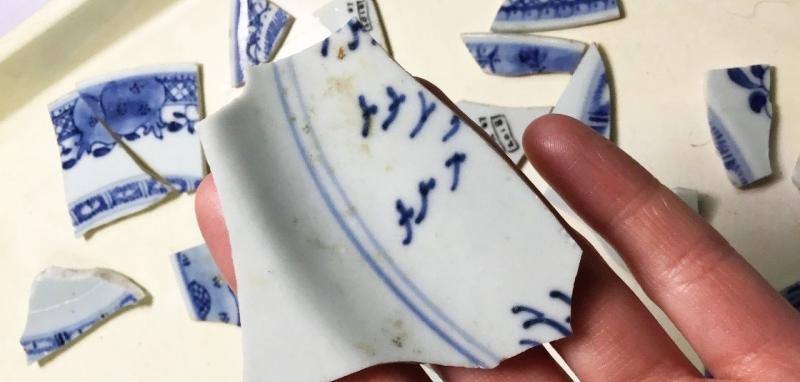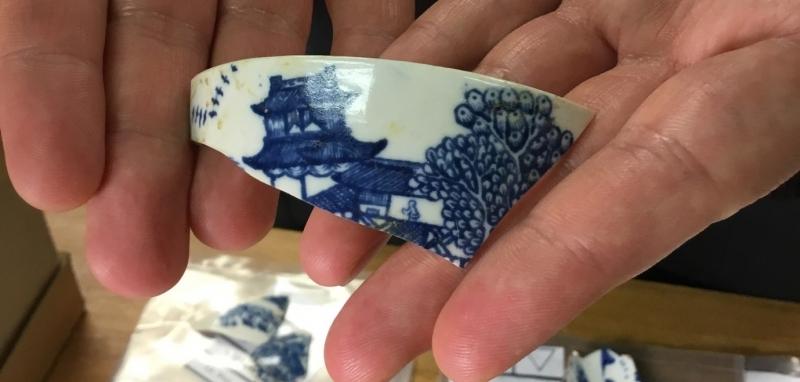MAAST in Motion: Made in China
In the latest update from MAAST, one of our participants, Han, gives an insight into the personal connection he has with Chinese porcelain and shares the questions that sorting and studying the amazing amount of Chinese porcelain discovered at America Square has raised.
As an amateur archaeologist and collector of Chinese porcelain, I am fascinated by the journey that led an item to the palm of my hand. An item whose owner and maker, as well as the very social and economic world in which it was created have long since departed. Yet, it is these discarded relics that offer the purest insight to a world long gone and allow us to access the lives of the users in the present day. Nothing can tell a more elaborate story of East-West relations than the development of trade. For how can a Chinese vase made in a small fishing town in the Qing dynasty, Fujian, end up on the table top of a Georgian English solicitor in London? This is but one question that puzzled me when Jacqui first arranged the hundreds of sherds of broken Chinese “China” for us to see.

The geese flying in the arrow head formation (above) spell the Chinese character “ren”, symbolising the changing of the seasons. They reminded me of my first summer trip to the Chinese Imperial gardens. Whilst sorting through the sherds, I could not help but notice the figure of a Ming dynasty fisherman sitting on his small wooden vessel in the lakes of Hangzhou. Some pieces we have looked at even contain traces of Manchurian and Han Chinese characters attempted by what one can assume is an illiterate kiln master. It was archaeology at a very personal level.
As I explained the illustrations to my English colleagues, I could not help but wonder about the individuals who painted, glazed and transported these items onto European ships. People whose eldest family members would have remembered when the Manchurian army entered through the Great Wall of China, when the last peasant revolt forced the last Chinese Ming emperor to commit suicide in the palace and when the very image of the Chinese people changed as they were forced to adopt the Manchurian Queue hairstyle.
I wondered if these regional artisans and labourers knew that their role in the production of porcelain for the European market had made them the unnamed promoters of international trade between two great empires.
It was inconceivable to me that hordes of this once fine China would end up in one location, buried beneath posh dwellings of the capital of the growing British Empire. It demonstrated proudly to me that the quality of the product and artistic talent of Chinese kiln masters of the early 18th century was so sought after by both the urbanised population of London and the landed gentry in the English countryside. It baffles the mind that English households would have entertained guests with these pieces of art without having the slightest clue as to the stories and symbols that were illustrated on their teacups.

“That’s English-made porcelain”, a voice tells me as I hold the shard of a teacup decorated with a typical Chinese blue and white illustration. “That is made here in London and its Chinese designs copied onto the piece through industrial scale printing.”
Dumbfounded, I quickly separated this piece with the other “made in China” pieces. The class sits quietly as Jacqui explains that the irresistible thirst for Chinese porcelain eventually drove British porcelain makers to manufacture their own products, often copying the Chinese designs and illustrations.
Unable to tell the two apart, I was told to look at the surface and the broken sides of the vessels to identify the subtle distinctions that differentiated the two identical items. Half an hour later the difference between bright hand-painted Chinese porcelain stone and warm English soft-paste vessels became obvious to me. It was all in the detail.
It is really incredible that these historical nuances can help create the foundations of Chinese and British modernity. As British porcelain from factories in Bow and Chelsea produced competition for Chinese imported vessels, it did little to dull the interest and fascination for Chinese products among the British public.
New orders continued to be delivered from kilns in Jingdezhen to aristocratic homes in Sussex as
older designs were phased out and discarded en mass into cess pits. The quality and craftsmanship of Chinese artisans continued to be studied by British pottery makers as East India Company ships made their journeys to Canton. It is ever more implausible to me that these two Empires once had such a symbiotic relationship over a mutual love of something so graceful. Before the unequal treaties and the carnage of the 19th century, there existed a period where Chinese elegance captured the imagination of the British public.
MAAST is made possible thanks to support from the Heritage Lottery Fund and The Radcliffe Trust. To follow the journey, follow #MAAST on Twitter, Facebook and Instagram.